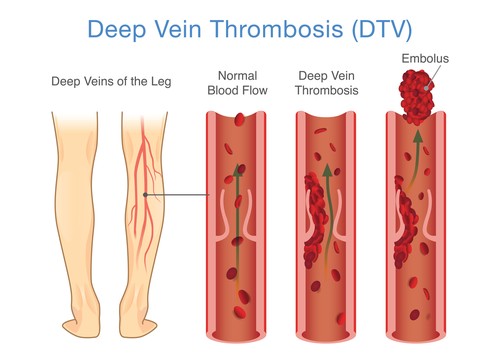
Contents
In this article, we will take a look at:
- What is deep vein thrombosis?
- How does deep vein thrombosis occur?
- Who is prone to deep vein thrombosis?
- Symptoms of deep vein thrombosis
- Diagnosis of deep vein thrombosis
- Complications of deep vein thrombosis
- Treatment for deep vein thrombosis
You can click on any of the links above to navigate to the section of your interest.
What is deep vein thrombosis?
Deep vein thrombosis (DVT) occurs as a result of blood clotting in a vein, which is deep inside the body. Blood clotting is defined as the slow movement of blood through the veins, causing a clump of blood cells. It generally takes place in the thigh, pelvis or lower leg. It is an alarming medical condition but can be treated.
DVT can affect other areas of the body as well. If the blood clots enter the lungs, then it might block the blood vessels, leading to pulmonary embolism. This situation can be of great threat to other parts of the body as well.
How does DVT occur?
DVT occurs due to blood clot in the vein. It can be a result of anything that stops the normal circulation of blood. These situations can include any injury to the vein, specific medications, any surgery, or restricted movements.
Who is prone to DVT?
You could be at risk of getting DVT if:
- You are overweight or obese
- You have a family history of DVT
- You are taking birth control pills
- You have any injury which could damage the veins
- You smoke
- You sit for long periods
- You are undergoing any hormone therapy
- You are on bed rest
- You are pregnant
- You have irritable bowel disease or cancer
- You have hereditary blood clotting disorder
- You have heart disease
What are the symptoms of DVT? How is DVT diagnosed?
The symptoms of DVT include:
- One sided swelling of foot, ankle or leg
- Severe pain in foot and ankle
- Cramps and pain in the affected leg, starting from calf
- Reddish, bluish or pale colour of affected skin
- Soreness and pain while standing
Diagnosis
After suspecting DVT, the doctor might conduct a thorough physical examination to check for the affected areas and seriousness of damage caused. The doctor might suggest few tests like Ultrasound, X- ray, MRI or CT scans, to detect the blood clot and its growth. Few blood tests can also be suggested by the doctor for the diagnosis of DVT.
What are the complications of DVT?
The symptoms of DVT are not visible in all the patients suffering from it and that is why it is usually noticed after it has sufficiently damaged the affected area. However, if diagnosed at the right time, it can be prevented from expanding and creating further damage. Some of the complications caused by DVT include:
- Breathlessness
- Sweating
- Dizziness
- Blood while coughing
- Pain in the chest, which gets worse while coughing or deep inhaling
- Rapid breathing
- Accelerated heart rate
What is the treatment for DVT?
The treatment for DVT concentrates on restricting the blood clot from expanding and reducing the risk of getting more blood clots. The doctor might prescribe medicine to thin the blood, which will stop the blood from clotting. The doctor can also suggest wearing compression stockings, which helps in reducing the chances of blood clots and prevents swelling. In case blood thinners don’t help in treating DVT, the doctor might try filteration process, wherein a filter is put inside the large abdominal vein to stop the blood from clotting. This process helps in preventing pulmonary embolism as well. The doctor might try clot busters to break the clot instantly, in case medications are not showing expected results.
Questions answered by trusted doctors



Did you know?
DVT generally occurs
DVT generally occurs in people above 50 years of age.
DVT symptoms
DVT can occur without showing any observable symptoms.
DVT
At times, patients find out about DVT, while undergoing a treatment for pulmonary embolism.
Related articles
Migraine is characterized by an excruciating pulsating headache. Find more about Migraine meaning, treatment, home remedies, reviews and queries. Get information, videos and facts about Migraine on Health-Wiki | Practo
Gout is an inflammatory form of arthritis that develops in people with high levels of uric acid. Know more about Gout, its causes, symptoms, treatment and other useful facts, links and videos on Health-Wiki | Practo
Dialysis is a procedure in which the blood is filtered mechanically without the help of the kidneys. If the kidneys are not functioning properly then Dialysis will take over the function of the failed kidneys.